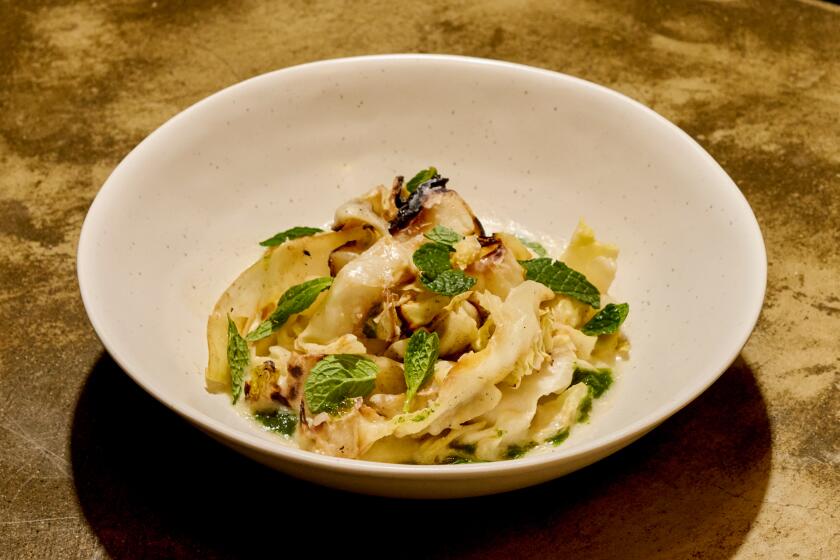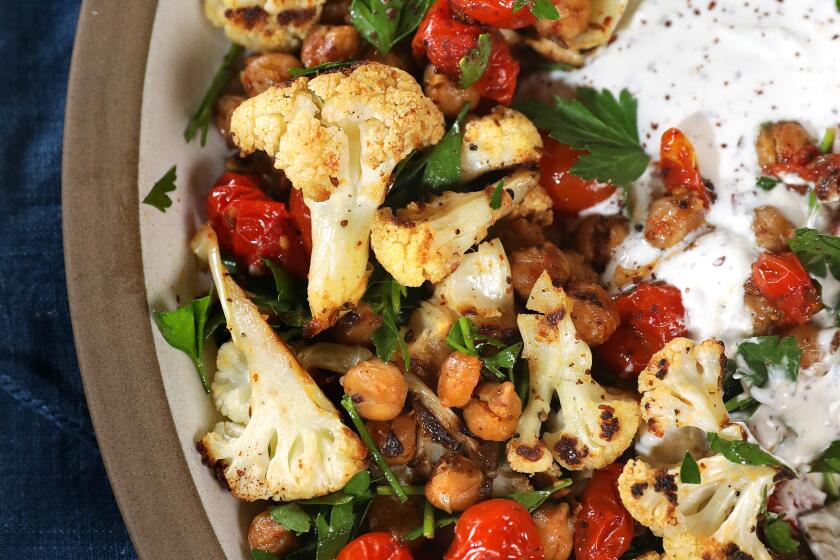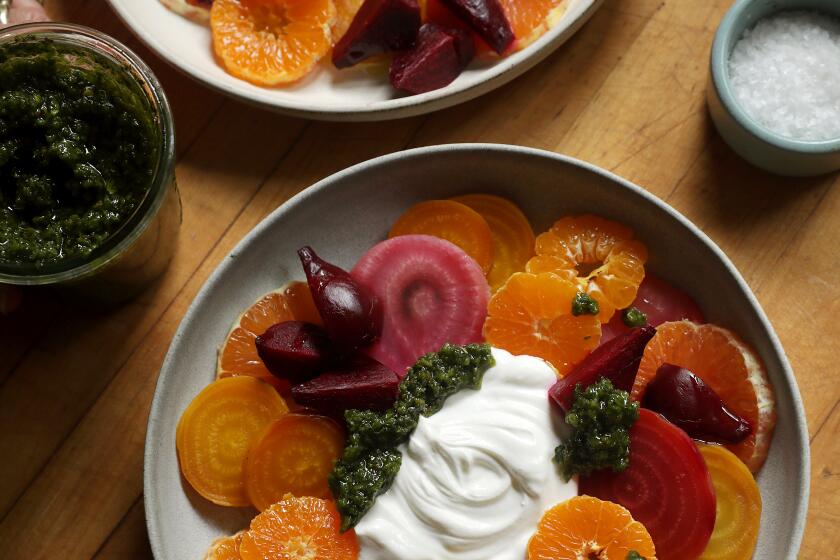German Potato Salad
Wisconsinites have a well-deserved reputation for being a friendly, easygoing lot. But there’s a sure way to start an argument, especially at this time of year: Drive down a rural county highway and pull into any local watering hole with a tin roof and a neon “Blatz” sign in the window. Park your car in the gravel lot among the pickup trucks and wood-paneled station wagons. Step into the bar and ask in a loud, clear voice, “Ya, hey dere: Can anybody tell me how to fry up a brat, eh?” Controversy will soon begin.
Ask about toppings and you’ll have a pier-six brawl on your hands. Like Italians with their red sauce and Hungarians with their goulash, there are as many recipes as there are cheeseheads frying up brats. And each passionately believes his is the best.
In Wisconsin, the bratwurst is not a sausage. It’s a regional ritual.
Every August since 1953, Sheboygan, Wis.--the self-proclaimed Bratwurst Capital of the World--has celebrated Bratwurst Day. It’s far from alone in its allegiance. This summer, as every summer, Wisconsin grills are being fired up from La Crosse to Manitowoc, from Kenosha to Lac du Flambeau, all to celebrate the legacy of the Badger State’s favorite grub: the bratwurst.
In Wisconsin the bratwurst is not just a staple food item but the centerpiece of a vibrant cultural esthetic. Like the Texas barbecue and the New England clam bake, the Wisconsin brat fry has its own traditional set menu, rich folklore and strictly observed rituals. Wisconsonites are nuts about their bratwurst, and once you’ve had the brat experience, you will understand why. The hot dog pales in comparison to the stalwart, meaty brat.
For a genuine Wisconsin brat fry, it’s important to get the right kind of brat. The various breeds of bratwurst can quickly confuse the uninitiated. There are any number of recipes, but the main spices usually include sage, mace, rosemary, thyme and celery seed.
You may have seen fleshy, white brats in your local grocery. These are the Nrnberger variety, also known as veal bratwurst, and are made of a mixture of veal and pork. Mnchner veal bratwurst is similar in appearance but has a slightly spicier flavor. Veal brats, like hot dogs, are sold fully precooked and need only to be browned on a grill.
But for our Wisconsin Brat Fry, the brat we want is all pork. This is the Thuringer bratwurst, named for Thuringia, the central German region where it originated. You will recognize it by its mottled appearance, like Italian sausage. Thuringers, in contrast to the veal types, are sold raw.
If all of this is beginning to sound a little confusing, not to worry. There are a few guiding principles that, once understood, can land you as close to the real thing as you can get 2,000 miles away from Wauwatosa.
First, start with good, fresh bratwurst. It can be obtained here in Southern California and is not as rare as you might expect. On occasion, I have seen Wisconsin brats in the meat sections of local supermarkets. The most common brands you may encounter are Johnsonville and Usinger’s. Both companies make respectable brats, but by the time they’ve traveled this far, they may be weeks old. They’ll be good, but not great. It’s well worth the effort to make the special trip to a sausage shop (see box) to get fresh sausages.
Next, you’re going to need beer, and lots of it. Before grilling, bratwursts are poached in a broth of beer, flavored with onions, butter, black pepper and maybe a little garlic. The simmering beer cooks the meat, while the subsequent grilling contracts the sausage skin to give it the snap that is characteristic of a great bratwurst.
The practice of cooking brats in beer before grilling isn’t as traditional back in the Old Country as it has become in Wisconsin. Gary Troub, bratwurst maker and proprietor of the European Deluxe Sausage kitchen in Beverly Hills, believes it to be an American innovation. He only heard of the method upon moving to Los Angeles 11 years ago from his home near Koblenz in the Rhineland.
“Cooking in the beer, that’s more something they do more in Milwaukee. Germans, we like to put the beer here,” says Troub, pointing to his mouth with his thumb.
“That’s right,” concurs Fritz Thaller, second-generation Austrian sausage maker and owner of Atlas Sausage Kitchen in North Hollywood. “Germans traditionally just put it on the grill, they don’t necessarily put it in beer. I personally like it, it does add some taste of the hops to the bratwurst. If I have American guests, I will soak the bratwursts in beer.”
As for the type or quality of beer used for poaching, there’s some flexibility. Tradition dictates that the beer be cheap. A good rule of thumb for beer lovers is to use the cheapest you would drink if a gun were held to your head. Certainly, the better the brewski, the better the brat, and if you have the financial means, you can use pretty good stuff. In any event, choose a lighter lager or ale, and steer clear of stouts and darks.
Be sure to stock plenty of beer for drinking as well. Beer and brats are an inseparable culinary pairing, like Champagne and caviar.
After the poaching, the brats are grilled to a deep brown. Then they are returned to the broth, brought once more to a simmer and served buffet-style, straight from pot to bun in a wonderful ritual of Midwestern informality.
The word “bun” may be a misnomer. Most brat enthusiasts get picky about their breads, calling for specific items such as “hoagie rolls” or the “Sheboygan hard roll,” a specially-designed bratwurst bun rolled in cornmeal before baking. Most sources will simply recommend “a hard roll.” A good six-pack of Italian rolls works well, or choose any kind of crusty, substantial roll you like. Even a good, sturdy brand of hot dog bun will work in a pinch, but toast it over the grill on both sides for a few minutes to give it some character.
Once you’ve got your beer in hand and your brat lying naked in the bun, you need to dress it. Now here’s where things get really picky. The most commonly accepted toppings are sauerkraut, horseradish, brown mustard and sometimes chopped onions.
There are regional variations: Some Sheboyganites actually regard sauerkraut with disdain, while happily committing the unspeakable heresy of slathering ketchup on their brats. I’m convinced this is a micro-regional aberration. The citizens of “Brat City” should know better. A brat without kraut is like a frulein without a dirndl. The refreshing nip of good sauerkraut is the perfect compliment to the rich, round flavor of a well-cooked brat.
Finding that sauerkraut, however, can be a challenge. Each brand has a remarkably distinct flavor and texture. Sauerkraut being something of an acquired taste to begin with, a thorough sampling of the available krauts might be more than many of us have the stomach for.
Used as an ingredient, kraut is often drained, even rinsed, and flavored with white wine, caraway, sugar, apples, juniper and a host of other possible ingredients. The results can be delicious. If you’re interested, I encourage you to explore and enjoy this wonderful food product.
For your Wisconsin brat fry, however, forget all that. Just find a kraut that tastes good to you, open the can and pile it on.
You’ll need mustard too. A middle-of-the-road brown mustard like Gulden’s is good, or a straightforward stone-ground. If all you have is bright yellow ballpark-type mustard, you might as well just skip it. Dijon can work, but be careful, especially if you add prepared horseradish. And really do try to have some horseradish, with as unadulterated an ingredient list as possible. Finally, a topping of fresh, chopped onions is a delightful option.
There you have it: Your Wisconsin brat.
But where’s the potato salad? You won’t find a brat in Wisconsin without a pile of German potato salad close by. American won’t do; no mayonnaise allowed. Bacon, vinegar and onion are the basis for the classic bratwurst accompaniment.
Please don’t cut corners and pick up a pint from your local supermarket deli. I can almost guarantee it will be too sweet. My mother’s rustic German potato salad is the best I’ve ever had, and foolproof. And it tastes better after resting a day, so try to make it ahead of time.
A good brat and potato salad make a respectable brat fry all by themselves, but for a summer celebration with family and friends, round it out with simple extras highlighting the fruits of the season. Like Southern California, the Midwest enjoys an abundance of summer seasonal produce. While a refreshing German-style cucumber salad will be a great addition to your Wisconsin brat fry, feel free to simplify. In true Midwestern spirit, serve grilled corn on the cob with this meal and carve up a cool, ripe watermelon for dessert.
Cook the potatoes in boiling salted water until tender, about 20 minutes. Drain the potatoes well, then peel and slice them.
Meanwhile, cook the bacon in a large skillet over medium heat until crisp, about 5 minutes. Drain and crumble the bacon, reserving about 1/4 cup of bacon fat.
Cook the onions in the reserved fat over medium heat until tender, 10 minutes. Stir in the flour, 2 teaspoons salt, sugar, celery seeds and pepper to taste. Cook 2 minutes. Add the 1 1/2 cups of water and the vinegar, mixing well. Cook, stirring often, until the liquid is bubbly, has thickened and coats the back of a spoon. If the sauce becomes too thick, add a little water or vinegar.
Stir in the bacon and potatoes. Cook until heated through, tossing gently to mix. If you prefer a more tart salad, add more vinegar while tossing.
Place the salad in a bowl and let it rest at least an hour. (Or cover and refrigerate it overnight. Bring it to room temperature before serving.)
Get our Cooking newsletter.
Your roundup of inspiring recipes and kitchen tricks.
You may occasionally receive promotional content from the Los Angeles Times.













